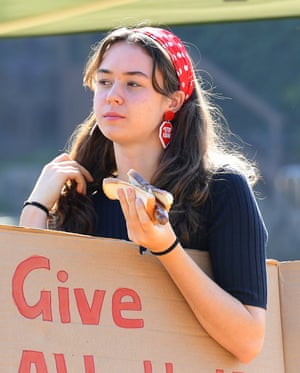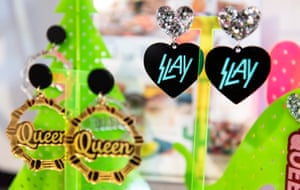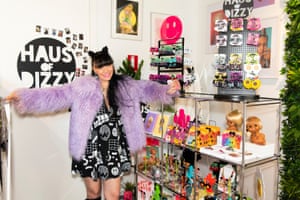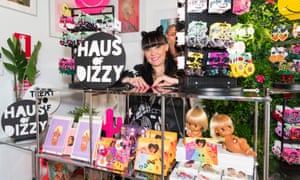Haus of Dizzy: 'It's a way to wear our voices on the body part that listens' - The Guardian |
| Posted: 17 Oct 2019 10:00 AM PDT There's something called the Haus of Dizzy nod. When you're wearing a piece by jewellery designer Kristy Dickinson, you get recognised by other members of her cabal. Actually, you get noticed by pretty much everybody. Enormous acrylic accessories promoting Aboriginality and inclusive values tend to make a statement – at the demonstration, at the club, on the red carpet, on the streets of Newtown or West End or Fitzroy. This is activism by cuteness.  "My friends always say Haus of Dizzy is just Kristy spewed up in earring form," Dickinson says. So, inside her head there's room for treaty, trans pride flags, 90s hip-hop, dinosaurs, teen fashion dolls and smashing the patriarchy. Her slogan pieces rep environmental campaigns ("Stop Adani"), feminism ("The Future is Intersectional"), gay rights ("Love is Love") and sweary mantras ("Fancy as Fuck"). Plus there's her Indigenous Pride range with First Nations flag hearts, "Faboriginal" hoops and "Deadly" necklaces. "I just want to give pride to my people," Dickinson says. "But in a cool, shiny way." Top End Wedding actor Miranda Tapsell is a well-known fan. "Aboriginal culture isn't considered trendy or cool in this country, so it's great to subvert it to the truth," Tapsell says. "Non-Indigenous people see me in my Haus of Dizzy earrings and they know where it's at. Also, every Blak person stops you to say, 'Is that Haus of Dizzy?' It really gets us celebrating one another."  Haus of Dizzy pieces are designed to make the wearer feel something: pride, power, confidence. Or sexy and assertive, Dickinson says. "I get so many customers who say, 'When I put these earrings on I feel so good and I make so many friends.' I had one customer who bought some 'Fuck Off' bamboo hoops. Next week she came back and said, 'Oh my God! I wore those earrings out, I felt so hot and I had free drinks all night. And two marriage proposals!'" Dickinson is a proud Wiradjuri woman. As a child, connecting to culture meant time with her nan and her glamorous, accessory-loving mum, or heading off to Dubbo for holidays with the extended family. "Going up to the country when I was little and talking to my aunties, sitting up at the kitchen table and hearing them all yarning around, that was my connection to my Aboriginality," Dickinson says.  But she also remembers getting teased for being Aboriginal, and crying when her mother tried to make her dress in black, yellow and red for a school flag costume day. It's one of those childhood memories that still makes Dickinson cringe. "I just wish I could go back and shake that little girl and go, 'Be proud of who you are and make your mum proud. Don't ever be ashamed of who you are.'" Or maybe she should say: "Hey little Kristy – I make jewellery that remixes the best bits of our childhood, and adds in some stuff that was missing first time around." One way she's doing that is by collaborating with artist Chontelle Hammonds on Indigenous Pride packaging – their illustrated brown girl brand mascot is part Barbie, part Baby-Sitters Club. "Growing up as a little brown girl in Sydney's inner west I always loved stick-on earrings and play jewellery, but always wondered why there [were] pretty little girls with blonde hair, blue eyes and fair skin on the packaging, and not a pretty little brown girl with brown eyes and lovely dark hair," she says via the Haus of Dizzy Instagram. "I made little Kristy very happy".  Wentworth star Rarriwuy Hick is another devotee, and sees Dickinson's work as empowerment: "Being an Indigenous woman and knowing what some of our daily obstacles can be, Kristy has used those struggles to empower us. But I don't see her just doing this for Indigenous women. She's doing it for the queer community, trans women, all women. It's a way to wear our voices on the body part that listens." Haus of Dizzy has a part-time assistant and an intern helping out now, but for most of the time since its 2015 launch the brand has been a solo operation. All pieces start with Dickinson's designs. They're laser cut using solar power then hand-painted and assembled in her Melbourne studio. In the early days, Dickinson mainly sold at markets – now it's online and through stockists like GOMA, Melbourne Museum and (soon) The Iconic. You'll still see her stall at Aboriginal events, though. And she makes time to run jewellery workshops at youth detention centres and domestic violence support centres. Dickinson talks a lot about instilling confidence in Indigenous children. As the daughter of a single mother, she says she never thought of owning a business. Dickinson financed it all herself – no loans, no grants – and hopes to be a role model for young people in her community.  But if Dickinson is a symbol, then so is the stuff she makes. She tells the story of one tiny Haus of Dizzy fan who won't go to school without her "Deadly" necklace on. So Dickinson and Hammonds are also working together on Dizzy Chicks, a brand new children's range with stickers, clothing, merch and accessories. So far they're working on six cute brown girl characters with individual personalities. A bit like an Indigenous Spice Girls. "It's something I didn't have when I was little," Dickinson says. And then she laughs when asked how much Haus of Dizzy is really about feeding her inner child. "All of it!" she screams. |
| You are subscribed to email updates from "bamboo earrings" - Google News. To stop receiving these emails, you may unsubscribe now. | Email delivery powered by Google |
| Google, 1600 Amphitheatre Parkway, Mountain View, CA 94043, United States | |



0 Yorumlar